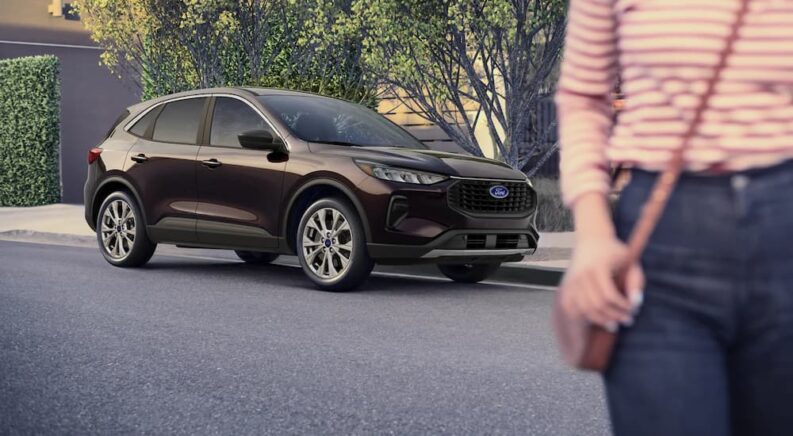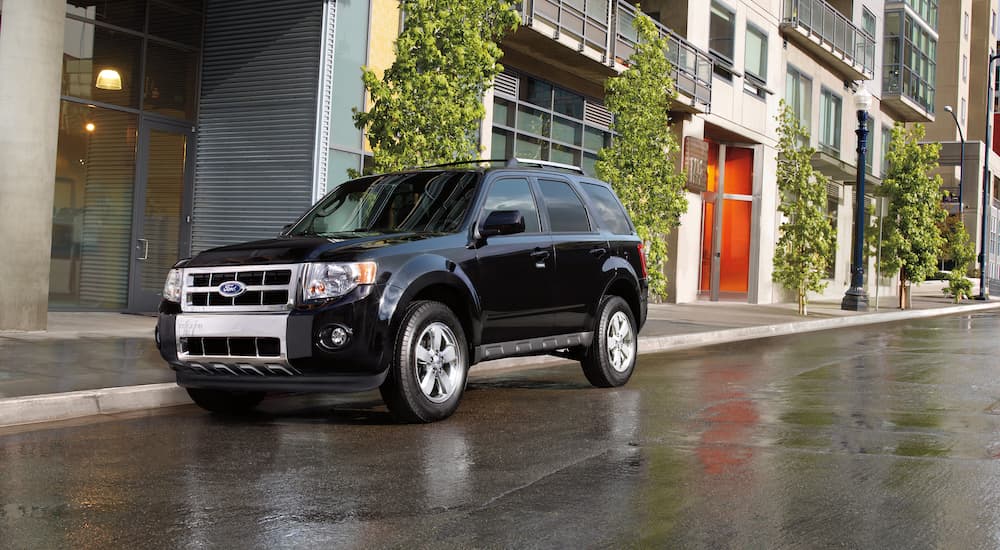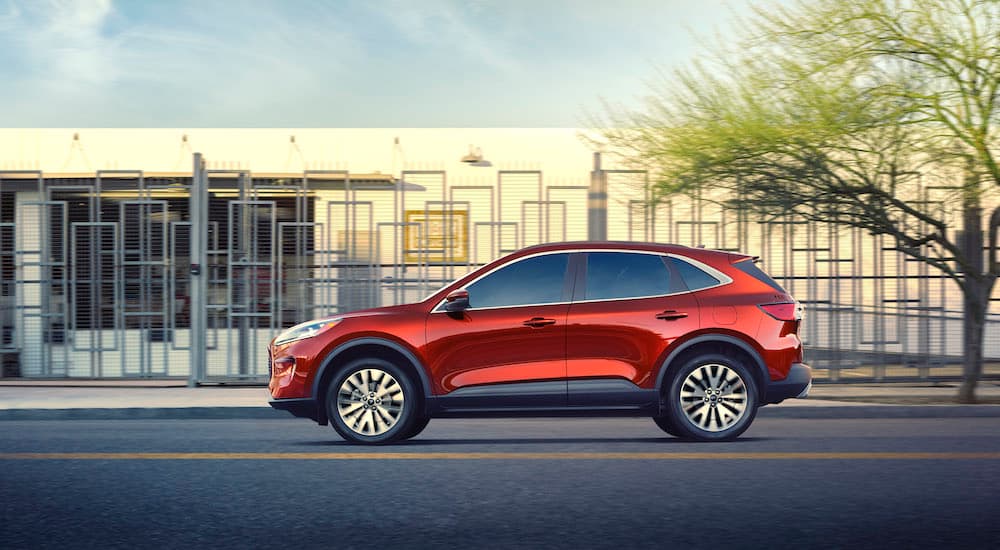Ford’s F-Series of pickup trucks may be the brand’s best-seller—and, in fact, the country’s best-seller—but it’s not the only Ford model with a rich history and modern popularity. Small SUVs are a popular segment in the American auto market, and Ford’s Escape has been one of the Top 25 best-selling vehicles in the country for several consecutive years now, selling over 100,000 units in 2022 alone. You can find this compact SUV on roads and in Ford dealerships from coast to coast these days.
To get to this point, the Escape had to stand the test of time. It’s been around for more than two decades and has evolved quite a bit to keep up with shifting trends and modern tastes. The Escape may have a very different body shape and way more tech features than it did when it first rolled off the production line, but through it all it’s hung onto the winning formula that made it competitive in the SUV segment pretty much instantly. It offers a refined ride, a spacious interior, and solid fuel economy for its segment. Let’s take a look at how the Escape has changed throughout the years and where it is today.
2000 – The Escape Debuts
The Ford Escape made its first appearance at the North American International Auto Show in 2000. This was quickly followed by a wider release for the 2001 model year. The Escape originally came standard with a 2.0L engine capable of producing 130 hp and 135 lb-ft of torque. For more power, drivers could upgrade to a 3.0L V6 that brought both horsepower and torque up to 200. Both powertrains were available with either front- or four-wheel drive.
Back in the early 2000s, compact SUVs weren’t the juggernaut they are today; it was still an emerging sector without the immense amount of competition we have today. This made the Escape’s mix of four-wheel drive capability, a high driving position, a roomy interior, and impressive fuel economy a unique one, appealing both to car drivers looking for more space and SUV drivers looking for better on-road performance and easier maneuverability. The Escape, therefore, came of age as this segment was rapidly gaining popularity. To put it into perspective with some hard figures, in the year the Escape made its US debut, small SUVs accounted for just five percent of total vehicle sales in the country; by 2014, that number had tripled to 15.7%.
Interestingly, the original Escape was the product of a collaboration between Ford and Mazda. The Mazda Tribute was based on the same platform and was produced between 2000 and 2011. Ultimately, the Tribute was replaced by the Mazda CX-7, a vehicle completely separate from the Escape. Ford also released a similar compact SUV under its now-defunct Mercury division called the Mercury Mariner.
2005 – Refresh Brings New Powertrains
The Escape’s first generation lasted for nearly a decade, but it didn’t stay static for that entire time. In addition to smaller tweaks made year after year, the Escape got a major refresh for 2005. The 2.0L base engine was replaced with a 2.3L version capable of 153 hp. A hybrid powertrain also joined the lineup, allowing Ford to claim the honor of producing the world’s first hybrid SUV.
With the hybrid powertrain and 2WD, a 2005 Escape can get up to 29 MPG city/highway combined, according to an updated rating from the EPA. Since the average 2023 vehicle gets a combined 28 MPG—also according to the EPA—that’s a highly impressive figure for an SUV, especially at that time. The hybrid powertrain could even propel the vehicle entirely on electric power for a limited time.
2008 – Generation Two
The second generation brought more modern styling to the Escape, both inside and out. The exterior was designed to look tougher and more squared-off, projecting the image of an SUV ready to tackle anything. The cabin gained a boost in aesthetics and storage for a more comfortable ride. For the 2009 model year, the base powertrain was updated again, becoming a 2.5L engine capable of 170 hp. The automatic transmission also got an upgrade, becoming a six-speed instead of a four-speed for improved fuel economy and driving dynamics.
2013 – Sleeker Shape for the Third Generation
Generation three saw a complete redesign from the ground up. Leaving the boxy look behind, the Escape’s body became sleeker and more aerodynamic. The array of powertrains was simplified, dropping the hybrid option and the inefficient V6 to focus on EcoBoost four-cylinder engines that sought to balance power and efficiency. Despite being smaller and more efficient than the base engine, the new 1.6L EcoBoost was able to produce more at 173 hp and 177 lb-ft of torque. A larger 2.0L EcoBoost was rated at 237 hp and 250 lb-ft of torque.
Ford’s Sync infotainment system was included as standard for all trims except the base S, giving the Escape a modern touchscreen-based infotainment setup. Upper trims offered even more high-tech features like blind-spot warning, a motion-activated power liftgate, and an automatic parallel parking feature. Ford’s Active Park Assist had already been available in the Ford Focus, but adding it to a large vehicle like the Escape—which can be even more difficult to park in tight spaces manually—was a major upgrade.
The Escape continued to evolve throughout this generation. 2016 saw the addition of a windshield wiper de-icer available through Ford’s Cold Weather Package. For the 2017 model year, the infotainment system gained Apple CarPlay and Android Auto compatibility. For the 2019 model year, all trims except the base S came standard with the Sync 3 infotainment system, one-touch up and down power windows, and keyless entry with push-button start.
2020 – Fourth Generation & Return of the Hybrid
All-new once again for the 2020 model year, the Escape saw plenty of changes, including an exterior redesign that gave the SUV a little more flair and personality and the return of hybrid powertrain options. Instead of a single hybrid powertrain, the 2020 Escape had two: a traditional hybrid that can get you up to 41 MPG city/highway combined and a plug-in hybrid that can get a whopping 105 MPG equivalent with the combination of the gas engine and the electric motor. The PHEV can also travel over 30 miles on all-electric power.
Ford’s suite of driver-assistance technologies, Co-Pilot360, became standard across all trim levels for the 2020 model year. Every Escape from this model year thus features forward collision warning, automatic emergency braking, lane keep assist, blind spot monitoring, rear cross-traffic alert, and more. Also standard is FordPass Connect, which allows drivers to get 4G LTE Wi-Fi for up to ten mobile devices.
2023 – Refreshed and Ready for Business
For the 2023 model year, the Escape got an exterior redesign once again, giving it a more athletic front end. The infotainment system was upgraded from Sync 3 to Sync 4, meaning it’s now capable of over-the-air software updates and wireless Apple CarPlay connectivity. An eight-inch touchscreen became the standard, with upper-level trims getting an even larger 12.3-inch version. The sporty ST-Line trim also joined the lineup. As the Escape continues to evolve in the years to come, we’re sure it will continue to reflect shifting trends in exterior and interior design and strive for increasingly efficient powertrains—perhaps even an all-electric version.






